This report describes a public event organised by the Faculty of Letters of Nishogakusha University in Japan and held in Jimbocho, Tokyo, on 4 February 2023. For more information on what has been an ongoing initiative since 2018, see the link below.
Wikipedia Town in Akihabara vol. 5
Together with the staff who prepared and operated Wikipedia Town for first-year undergraduates, and facilitator Araisyohei, we now proceeded to prepare Wikipedia Town for the public. We decided to follow the format of a standard Wikipedia Town. The satellite campus of Nishogakusha University in Akihabara, Tokyo, had been the base, but since the satellite campus was closed and the topics selected were concentrated in the Jimbocho area, a rental space near Jimbocho Station was rented for the event. We wondered what to name the event, which had been titled “Wikipedia Town in Akihabara,” given the relocation of the venue, but decided on “Wikipedia Town in Akihabara vol. 5” to carry on the numbering system.
Article Writing Items
The theme of this year’s event was disasters. From this perspective, we decided to cover the following two topics. One is Awaji Park. Located between Akihabara and Ochanomizu Stations, the park is now attached to the WATERRAS large-scale commercial facility, and was originally called Reconstruction Small Park attached to Awaji Elementary School, which was rebuilt after the 1923 Great Kantō earthquake. It was hoped that by researching its history, it would be possible to unearth some form of memory of the disaster. The site of the park is also the birthplace of Kaisei Junior and Senior High Schools, which are now located in Nishi-Nippori, and a stone monument, “The Birthplace of Kaisei Gakko” has been placed there. It was considered an expansive topic in this respect as well. The other is Nanmeikan. The Nanmeikan was located next to the “Goto Inari Shrine,” which was featured in the Wikipedia Town for first-year undergraduates, and was a kanboba (a commercial facility that was the predecessor of department stores) that existed from the Meiji to Taisho eras. According to the history of Nanmeikan, it was rebuilt after its predecessor, Koshukan, was destroyed by the Great Kanda Fire of 1892. The Kanda area has historically been repeatedly damaged by large fires, and we thought that the history of fires could be unearthed through this Nanmeikan.
Material Research
Material research was conducted mainly at the Chiyoda Library in Chiyoda-ku, Tokyo, but some materials were also obtained from the Hibiya Library and the National Diet Library. The following is a brief summary of the materials.
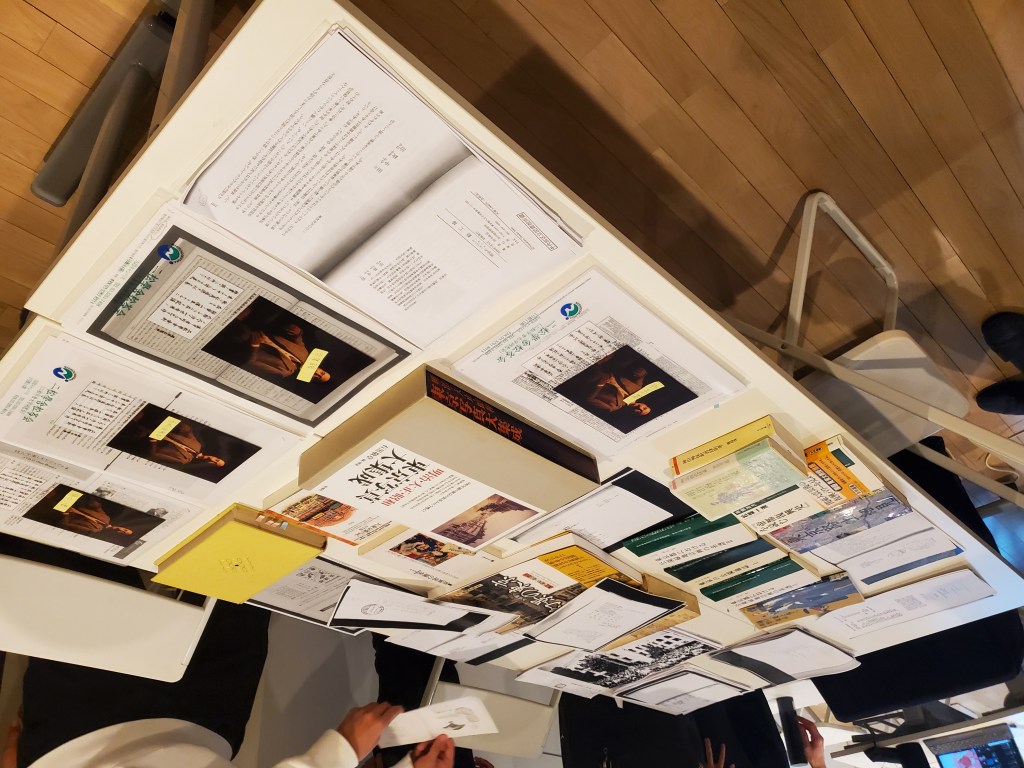
Regarding Awaji Park, the materials can be categorized into four major groups: 1) those related to the redevelopment directly connected to the current Awaji Park, 2) those related to reconstruction from the Great Kanto Earthquake, 3) those related to Awaji Elementary School, and 4) those related to Kaisei Junior High School. The most significant discovery during the research was a commemorative collection of materials from the Chiyoda Library that was compiled by people related to Awaji Elementary School. The books vividly recorded the school life of the elementary school students who studied at Awaji Elementary School with Awaji Park on the side, and at the same time provided a very broad and detailed historical background of the location and the surrounding area. However, since the subject this time was not Awaji Elementary School but Awaji Park, there was a lot of information that could not be covered even if we had wanted to. A photo collection titled “The Commemoration of the Inauguration of the New School Building for Reconstruction,” which was stored in the special research room of the Hibiya Library, was very impressive because it recorded the brand new appearance of the auditorium and inside each classroom of Awaji Elementary School immediately after its reconstruction. The school history of Kaisei Junior High School also contains a vivid picture of students standing dumbfounded in front of the school building that collapsed after the Great Kanto Earthquake, which was a topic we wanted to cover in this workshop on disasters, but were unable to do so.
Regarding the Nanmeikan, the materials can be categorized into five main groups: 1) those related to its predecessor, the Koshukan; 2) those related to the rebuilt and renamed Nanmeikan after it was destroyed by fire; 3) those related to Ichiyo Higuchi, who was also associated with the Nanmeikan and the Koshukan; 4) those related to the Nanmei Club, which was reorganized as a rental event hall; and 5) those related to the Nanmeiza, which became a movie theater after the Nanmei Club. The most significant finding in the examination of these documents was the detail of the damage caused by the fire that destroyed the Koshukan. 24 people were killed in the Great Kanda Fire of 1892 (Meiji 25), of which 18 were victims at the Koshukan. Research has revealed that the enormous damage caused by the fire led to the creation of a new law concerning commercial establishments, which stipulated the installation of emergency exits and evacuation routes. In addition, in an issue of “Fuzoku Gaho” published in 1892, we found an article on the fire at the Koshukan. In the article, the names and addresses of 17 people who died in the fire (plus one person whose name and residence unknown) were listed, and I was shocked to find a brutal and graphic illustration of the fire at the Koshukan. However, due to time constraints, we were unable to include the above details in this article due to the volume of information involved. Also, the illustrations could not be uploaded to Wikimedia Commons because I was not able to completely dispel the copyright concerns at that time. As for the Nanmei Club, we learned that Yoshino Sakuzo made a speech at the Nanmei Club, which was a decisive turning point in the Taisho democracy movement, but due to time constraints, we were not able to include it in the article too.
Announce and Preparation for the Event
In parallel with the material research, we started announcing the event using Peatix, an event management platform. We also proceeded to select the route for the city walk that would be conducted as part of the workshop. We researched historical buildings in the area surrounding the topic to be covered and came up with a list of possible routes, with a round-trip time of approximately one hour. Focusing on places that would relate to the theme of the disaster and also allow the participants to experience the history of Jimbocho and the Kanda area, a walking route was developed from the venue to Awaji Park via Kanda Nishikicho Sarashina, Goto Inari Shrine, Majong-kiya, and a monument commemorating the earthquake disaster. Although announcement was launched only a month before the workshop was to begin, eight participants had signed up by the time reservations were made.
The day of Wikipedia Town
The staff members gathered one hour before the workshop was to start, set up the venue, and then checked in participants. The following is the timetable of the day.
| 10:00 – 10:15 | Registration |
| 10:15 – 10:50 | Explanation of the purpose of the event and explanation of editing Wikipedia |
| 10:50 – 12:00 | Field research/photography for articles |
| 12:00 – 13:00 | Lunch break |
| 13:00 – 15:30 | Article writing |
| 15:30 – 16:00 | Article review/reflection |
| 16:00 | Dismissal |
Although there were some participants who had participated in previous Wikipedia Towns, only one participant was involved in writing Wikipedia articles on a daily basis. One participant was editing a Wikipedia article for the first time. The rest of the participants were at the level of having edited an article but not remembering it very clearly.
The workshop began at the scheduled time of 10:00 a.m. After an explanation of the purpose of the workshop, the facilitator gave an orientation and Associate Professor Kanta Tanishima of Nishogakusha University explained the subject matter. After a brief self-introduction of the participants, they were divided into two teams of four according to which of the two topics they were interested in writing articles about.
Prior to the city tour, a handout of past photos of the locations along the route was distributed. Referring to the handout, the group walked for about an hour to Awaji Park, stopping occasionally for explanations by the staff. Since Nanmeikan, one of the topics of the tour, no longer exists, we could only confirm the location where the building should have stood in the past. However, since the Goto Inari Shrine, which is shown next to Nanmeikan on the Meiji era illustration, still exists today, we spent some time there taking pictures. As for Awaji Park, it is attached to WATERRAS, a commercial facility, and has a rather unusual shape for a park, so it was a trial-and-error process to find the best angle from which to take pictures. After a lunch break, the participants gathered at the venue at 1:00 p.m. to begin the afternoon’s work.
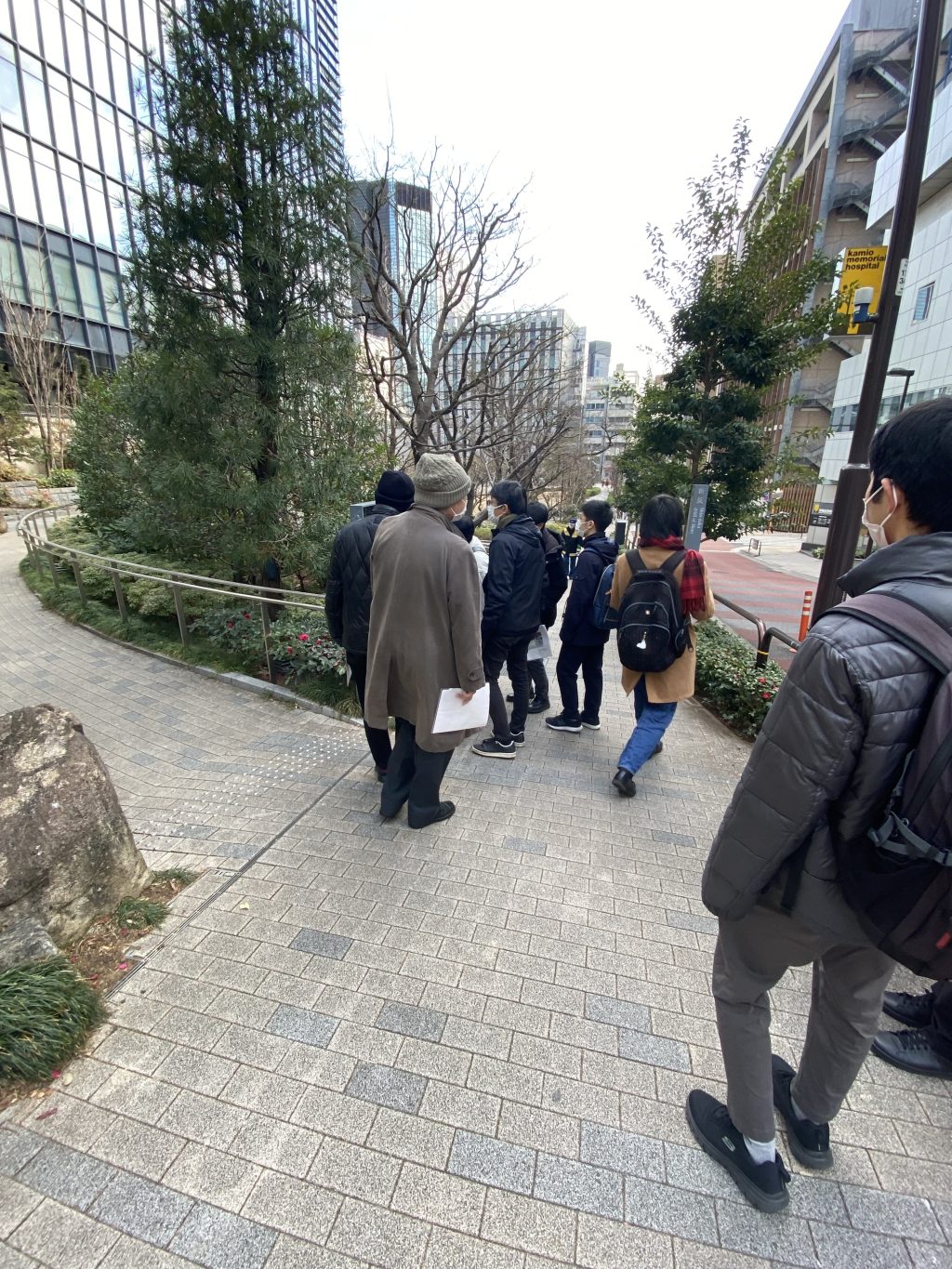
File:Wikipedia_Town_in_Akihabara_vol.5_2023-02-04(5).jpg on commons.wikimedia.org / Photo by Celtic-Yusuke / CC-BY-SA-4.0

File:Wikipedia Town in Akihabara vol.5 2023-02-04(7).jpg on commons.wikimedia.org / Photo by Celtic-Yusuke / CC-BY-SA-4.0
In the afternoon, each group started by composing a draft of an article while searching for reference articles. As we had imagined beforehand, “Awaji Park” seemed to be the more difficult of the two topics to compose an article on. The “Nanmeikan” article could be organized by summarizing the events in chronological order, but the “Awaji Park” article would require some creative compositional ideas in terms of how to incorporate Awaji Elementary School, Kaisei Junior High School, and other deeply related but non-subject matters into the framework of the “Awaji Park” article. Fortunately, a participant with a wealth of experience in writing articles for Wikipedia was able to understand this and joined the “Awaji Park” team, and under his lead, a draft article structure was created.
Once a draft of the article structure was prepared, the team moved on to the phase of assigning responsibilities and reading related materials. Sticky notes were provided at each table, and the facilitator advised the participants to write down the necessary information on the sticky notes along with the source information of the materials. As the participants read the materials silently, the staff introduced materials that might be helpful to them. Sticky notes with information are pasted on each part of the article’s organization chart organized on the whiteboard. Occasionally, a soliloquy is heard, either as a signal that information has been found in the materials that could be used, or as the sound of information processing in the brain as it builds up an image of the text to be written. Gradually, the time is ripe. Before I knew it, the sound of participants typing on the keyboard was getting louder and louder.
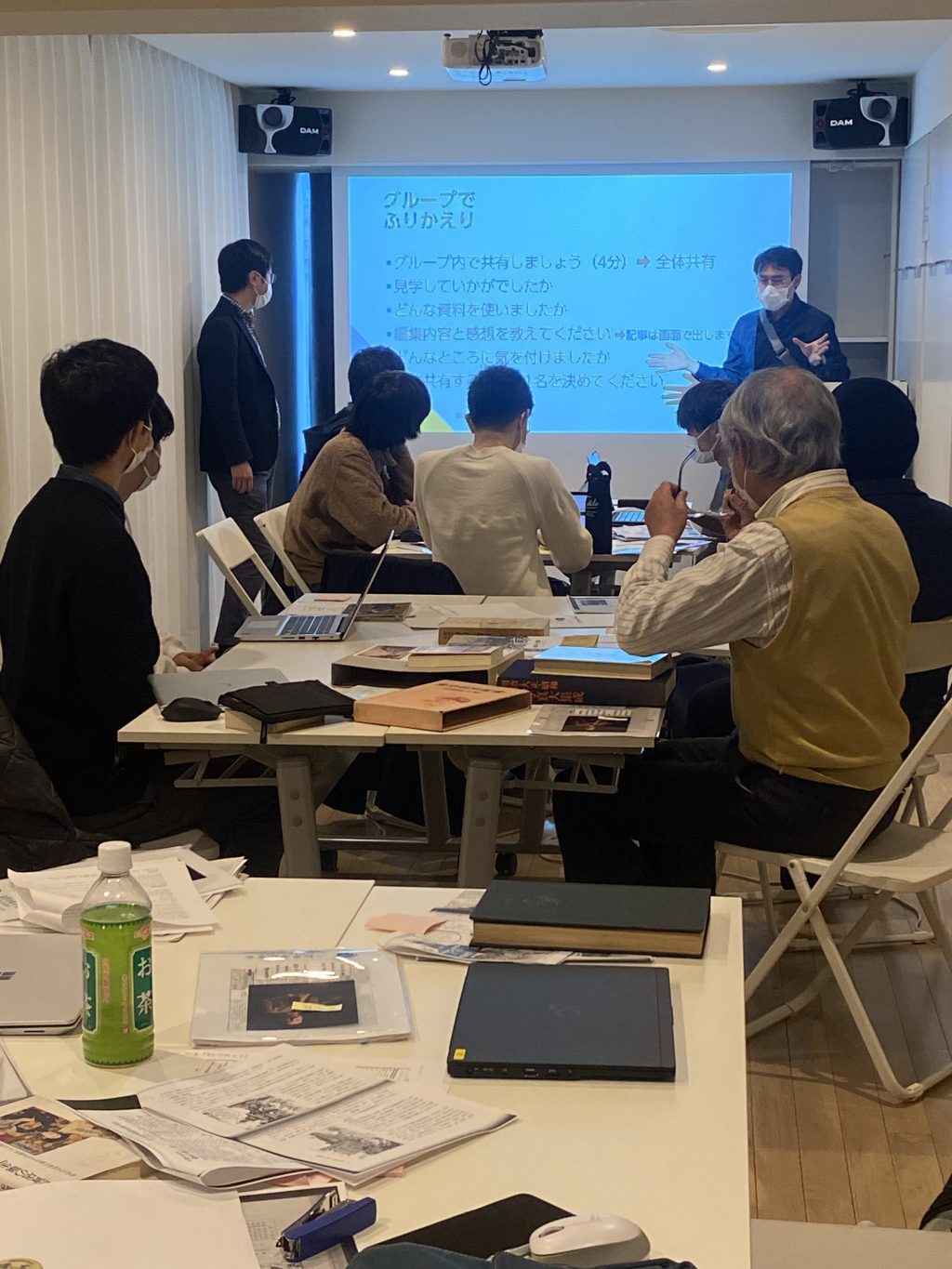
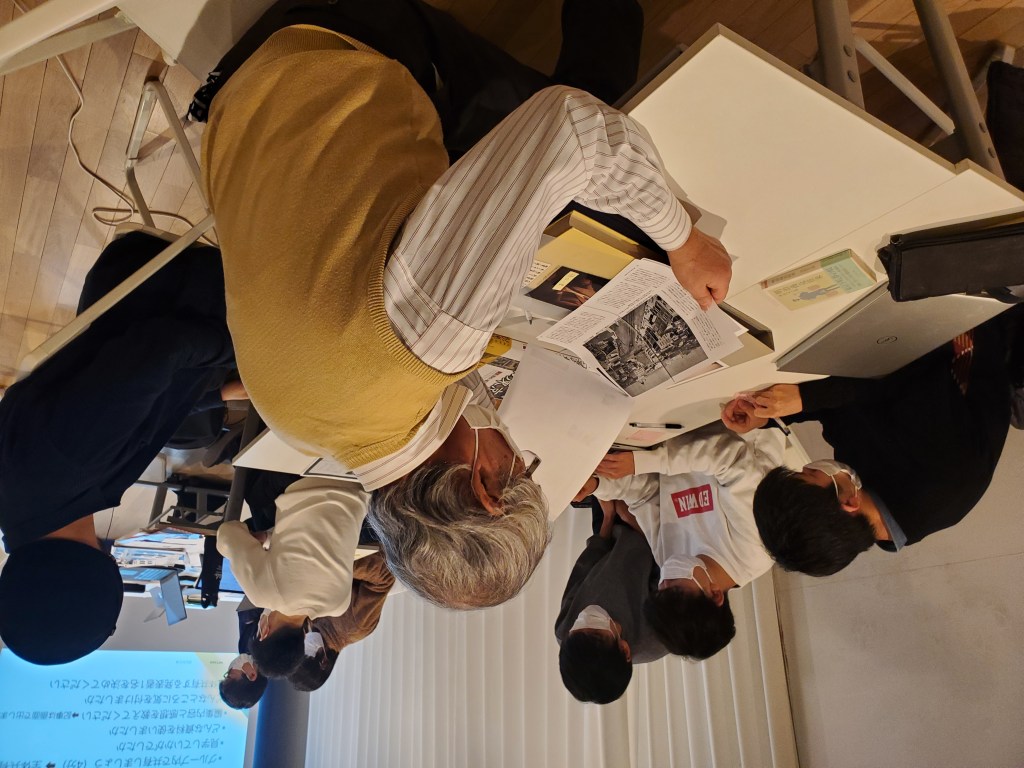
Wikipedia Town is like a middle-distance race with a slow start that accelerates as the second half of the race progresses, and by the time the participants actually start writing, they are almost in the last spurt. Before you know it, there is less than 30 minutes before the scheduled start of the critique. The first step in publishing an article is to prepare a new article as a container. After that, the articles are composed in turn, calling out to each other to avoid editorial conflicts. The parts prepared by each member are assembled. Once the article is roughly finished, the photos taken during the city walk are uploaded to Wikimedia Commons and incorporated into the article. Adding source information is a time-consuming process. With the support of the facilitator, participants added notes and source information. If the numbers are not consistent in notation, they will be corrected as well.
About 30 minutes later than scheduled, we started the critique part. The articles themselves had already taken shape, but the sound of keyboard tapping was still echoing in the background as we prepared for the critique, which was a usual scene. Each team selects one representative to explain the content of the article. From my experience, I have the impression that the youngest member of the team often becomes the representative, and this time was no different. The second year and third-year university participants each gave a brief report. Both articles were well structured and carefully annotated with source information.
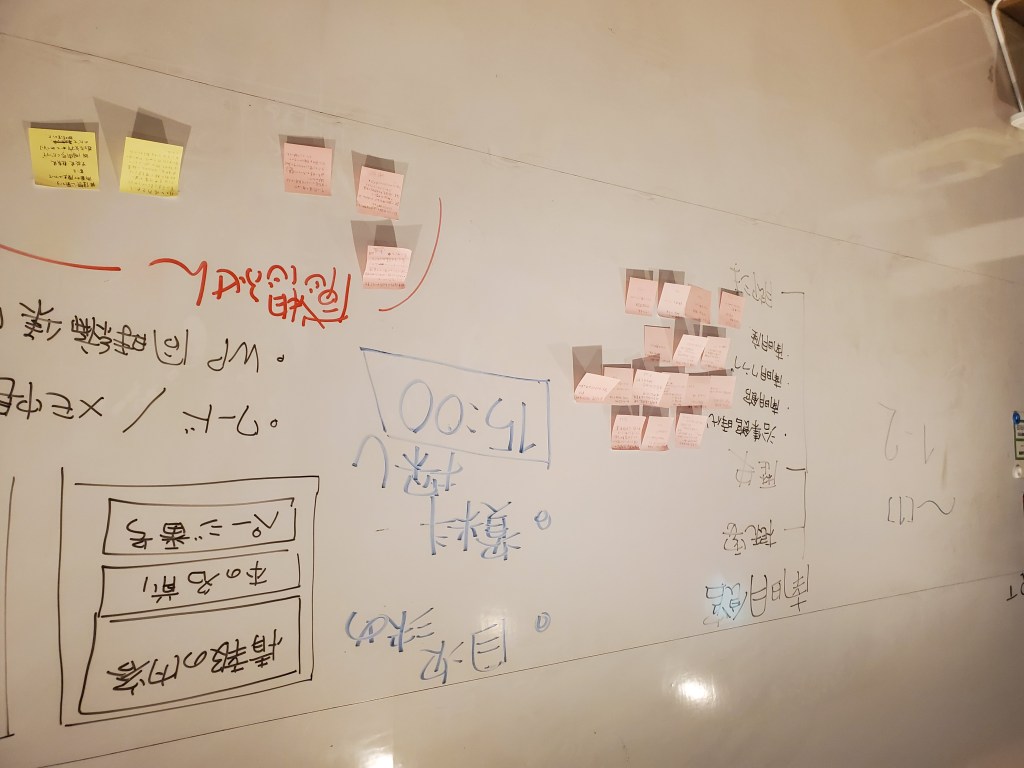
The following are the comments made by the participants on sticky notes.
- When I visited different places and compared old photos, I got a different impression and saw things from a different angle than now.
- In editing Wikipedia, we tried to look at different articles so as not to cover the wikis that the members were referring to.
As well as enjoying the work, many participants seemed to enjoy the learning experience and the social significance of the project. In addition, the following comments were mainly made as reflections/suggestions in the post-questionnaire.
- I want more time to work
- I would like more time for communication between groups
- Writing could have been more efficient if notation rules etc. were shared in advance
- During the city walk, the group might need to be more creative when passing through narrow streets.
This was the first time for us to move from Akihabara to Jimbocho as our base for Wikipedia Town, and from the material research stage, we repeatedly felt the depth of Jimbocho as a place. Nothing has been decided yet for next year, but for the time being we are considering conducting a Wikipedia Town based on the theme of Jimbocho itself. We already have several candidates for topics for articles. The title “Wikipedia Town in Akihabara”, which has continued as a series, may be changed to “Wikipedia Town in Jimbocho”. The fact that we are thus drawn by the gravitational pull of the location is probably one of the charms of this workshop.

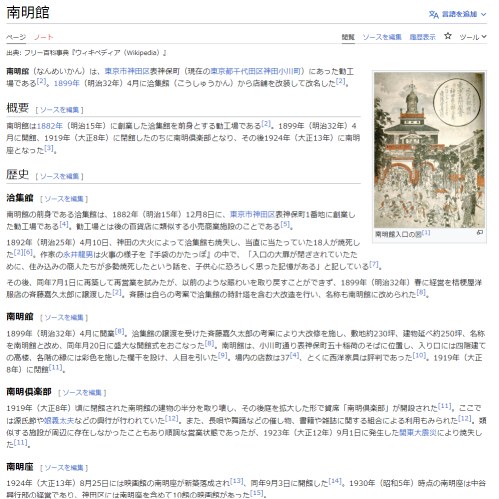
Finally, I would like to conclude this report by introducing the reflections of three students who were involved in this workshop as staff members.
This was a long-term project that lasted about six months, but I am glad that we were able to finish it successfully. I usually only looked at Wikipedia when I was searching for something, but I think the biggest difference was that through this project, I went from being on the side of looking at Wikipedia to being on the side of being looked at Wikipedia. Although some of the preparations for the smooth running of Wikipedia Town were difficult, I was pleased to hear participants say that they had fun and that they were glad to have participated in the project, which made me feel that my participation in this project was worthwhile.
Seima Goto
There were many things that were new to me in the operation of Wikipedia Town, and I often had a hard time. Since I had never had a chance to use the library before, it was a new experience for me to use the reference service and gather materials while browsing through local histories in the closed stacks. On the other hand, I realized how difficult it is to select materials according to the participants and their purposes, and to find relevant materials. On the day of the event, I felt the need to solidify my knowledge of manuals because I was not strong enough to instantly solve problems when errors occurred.
Although there were many things, I was not able to do overall, I am glad that I was able to experience the process of creating a single page and learn more about things related to the subject matter through the library. I also felt a sense of accomplishment when I published the Wikipedia article and the moment it came up in a search.
I hope that Wikipedia Town will not end this time but will continue to be held in the future.
Shunsuke Nakamura
First of all, I am glad that I was able to finish this project successfully. I was involved in this project with absolutely no knowledge of Wikipedia, and to be honest, I was worried that I wouldn’t be able to finish it. However, as the project progressed, we found the work we did rewarding. In particular, we spent many days in the library searching for materials, planning and preparing for the success of the project, which were all very hard work, but we feel a sense of achievement having successfully completed the project. I hope that many people will become interested in Wikipedia and Wikipedia Town through the university in the future.
Ryota Michiba
In the next academic year, I would like to pass the baton to the next grade and further improve Wikipedia Town.

Can you help us translate this article?
In order for this article to reach as many people as possible we would like your help. Can you translate this article to get the message out?
Start translation